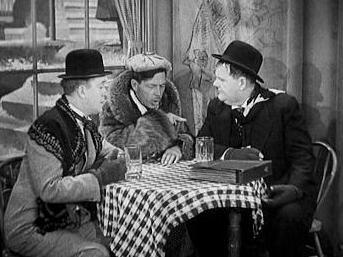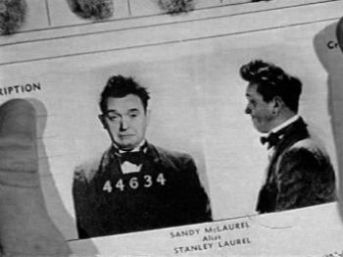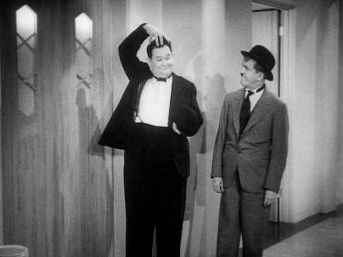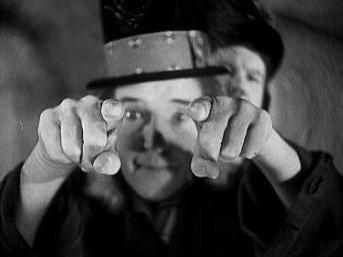(January 1935, 21m) Director: Charles Rogers Released: MGM, February 9, 1935  Laurel and Hardy appear as two greeting card salesmen, unwittingly getting involved in a duel for Ollie's life after they're employed by a neglected wife to make her husband jealous. A remake of the silent Slipping Wives, made over eight years earlier, and an illustration of just how much Laurel and Hardy's style slowed down in the interim. The rapid move away from the traditional 'cranked up' silent style of the day was a conscious move on behalf of the team, all the way back from their origins. Stan recalled in a 1957 interview with Arthur Friedman that 'we slowed down in our shooting in the speed of the film. [...] They used to shoot at 12, so we went to normal, 14, 15 or 16. We acted normally, we stopped to take... to show the reactions. Normally in those days they'd take a pie in the face and they'd jump up and run and make funny gestures and what have you. But as soon as we got our pie we deliberately stopped and you could read the man's thoughts. [...] Getting the most out of it.' Also notable here is the lack of size difference between the two leads. With Hardy having lost so much weight throughout 1934 and Stan having put on weight in his early forties they no longer meet the stereotype of 'the fat one and the thin one' but are instead two almost averagely-sized men doing humorous things. In all, The Fixer-Uppers is a decent but not outstanding short that makes you wish Arthur Housman had done more films with them after 1936, and also makes you realise that the expression 'make love' meant something very different in the 1930s.    (April-June 1935, 80m) Director: James W. Horne Released: MGM, August 23, 1935  Tensions between Stan and Hal Roach had developed to such a high level in March 1935 that Stan refused to sign a new long-term contract with the studio. As Laurel and Hardy were under separate contracts and Hardy's contract was still current, then the studio announced a plan to create a new series known as 'The Hardy Family'. Due to feature Hardy and Patsy Kelly with Our Gang's 'Spanky' McFarland as their son, plans were put on hold when Stan renegotiated terms and resigned to make 'McLaurel and McHardy'. An interview with Stan included in a 1991 South Bank Show special revealed that Stan's own take on the retitled Bonnie Scotland wasn't particularly favourable: 'I thought it lacked very much because Roach, Hal Roach and I, we differed a great deal on story ideas and gags and what have you. And we didn't get along too well on that picture, we disagreed very much.' Laurel and Hardy is a surprisingly anglophile-orientated series, possibly borne out of the silent era where an Englishman could act with a guesting Scotsman and other supporting Englishmen without the audience even being aware of it. By the time the sound era came along Charlie Hall was putting on a mock-US dialect anyway, though Laurel and Finlayson remained cultural outsiders. This unusual state of affairs is continued here, as the team made the odd decision to produce a Hollywood film based in Scotland. Naturally, the entire thing was filmed in California, and featured June Lang, an actress from Minneapolis, playing a Scottish heiress with a cut glass English accent. Lang's accent is actually very impressive... for someone English, at any rate. Although ostensibly a 'pure' Laurel and Hardy movie, the level of the irrelevant subplots surrounding them can be attested by the fact that they never share scenes with Lang's character, and she reputedly never even met them in real life. Perhaps most frustratingly of all, Lang's romantic subplot is never even resolved onscreen. The second half of the film enters Beau Hunks territory as the boys get roped into the army and battle with some stereotyped Arabs by throwing superimposed bees at them. Yet despite such questionable scenarios, when Stan and Ollie are on screen then Bonnie Scotland is frequently amusing. Laurel - or McLaurel here - gets to badly attempt to speak Scottish, saying to his hotel landlady 'hoots mam' and 'you're darn hootin''. Add to this Hardy at his pompous best, throwing out such unwieldy lines as 'Once again I have to come to your rescue and be the mother of invention' with aplomb. Other amusing moments include the pair of them using their jail photo fits as identification, and a pleasing dance routine showing that Hardy had a lot of grace for a man who weighed over 250lbs. Really that's Bonnie Scotland all over... an averagely amusing film when Stan and Ollie are on the screen, a crushing bore when they're off it.    (June/July 1935, 20m) Director: James W. Horne Released: MGM, March 16, 1935  The final Laurel and Hardy short is one of their lesser-remembered efforts, largely because it doesn't have a strong central plot, but is instead almost a series of vignettes. That's not to say that Thicker Than Water isn't a solid effort, and it's a shame that audience and studio needs forced them out of making a form with which they were so adept. Cameos aside, after this point Laurel and Hardy made seventeen films, only three of which were classics and eight of which were the worst films they ever made. In terms of plot, then Thicker Than Water begins with an amusing domestic setting, then moves into an auction subplot before emerging with a tacked-on 'body horror' ending where the two leads experience a blood transfusion gone wrong and end up with confused identities. Though Hardy is usually the more relaxed actor of the two in front of a camera it's notable here that Stan is more adept at lip-synching and imitating the mannerisms of his partner. There's also the sense that after nine years together - eight in the 'Stan and Ollie' characterisations - that Ollie onscreen is now resigned to his perpetual fate. When their grandfather clock is inevitably driven over less than two seconds after they put it down in the middle of a road Ollie's frustrated lack of verbal expression works because we've seen him rage before. Here he's gone beyond rage and into embittered acceptance, the look of a man who no longer expects any better. Perhaps most striking about their final short is that they take the breaking of the fourth wall to its furthest extreme yet, with three instances of the leads being aware they're in a film and pulling in the next frame. Stan, desperate to escape the wrath of Ollie's wife, accidentally lets it go and runs back to grab it, aware that the only way he can leave the scene is to bring in the next one. Like many Laurel and Hardy films, the comic ideas aren't always developed as well as perhaps they might be, and so what could be an innovative post-modern gesture seems merely thrown into the mix of what is at heart an unfocussed film. Thicker Than Water isn't about great ideas or great art, it's just there to amuse, and on those terms it succeeds admirably.     (August 1935-January 1936, 71m) Director: James Horne and Charles Rogers Released: MGM, February 14, 1936  Hanging over The Bohemian Girl was the mysterious death of Thelma Todd. Found dead in her car from carbon monoxide poisoning in December 1935, her death was ruled as accidental. However, theories persist to this day that Todd was either the victim of suicide, gangland murder or forced imprisonment. Her boyfriend Ronald West was reputed to have confessed in 1951 that he kept Todd locked in a garage in order to prevent her from going to a party... Todd kept the car heating on to save herself from getting cold and the death was accidental. Todd had appeared with the boys in their very first sound film, and appeared with them in three more shorts (including one of her own series, On The Loose) and also featured in their third feature, Fra Diavolo. Her death came when Todd was just thirty, and most of her scenes were cut, with Zeffie Tilbury reshooting sequences as a much older Gypsy Queen. Initial shooting on the feature was far from relaxed, either. Hardy had written to Myrtle that 'there has been so much silliness on this picture Stan was laid up for 2 1/2 weeks Mae Busch for 4 weeks it seems we have been at it for a year'. Part of the problems involved Hal Roach, tied up with studio business, but initially scheduled to direct the dramatic scenes just as he had done with Fra Diavolo. In the end result Charles Rogers filled in, though further tensions were brought to bear when Stan did one of his semi-trademark bodily distortion endings, he and his partner alternately shrunk and stretched as part of some medieval torture. What remains is, despite the problems of filming, a charming operetta. Laurel and Hardy get a little submerged in the subplot at times, but the picture has a far more developed narrative than the disjointed Bonnie Scotland and their place within it seems more assured. Such beliefs are aided by familiar faces taking roles to make it feel more like a regular picture - Mae Busch is on hand in her final Laurel and Hardy role as yet another bullying wife for Ollie. Many of the musical scenes feel a little too rigidly blocked and lack a true cinematic scale, but for the two stars it's a fine addition. Stan has notably put on even more weight and his character is more intelligent than usual, perfectly fitting Hardy's own belief that Ollie never realised that he was actually the dumbest. Although Stan's intellect falls to normal low levels by the end of the picture, we get to see him outsmarting Ollie on several occasions, and educating him in the ways of thievery. Stan even manages, in his mid-forties, one final leaping 'scissor kick', a throwback to his old solo days and something phased out of the movies after One Good Turn/Any Old Port!   
|
||||||||||||||||||||||||||||||||||||||||||||||||||||||||||||||||||||||||